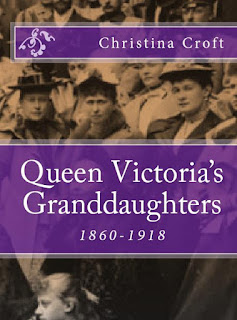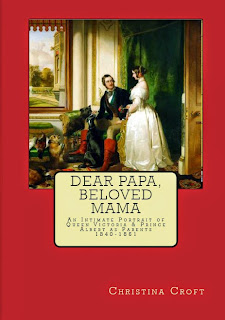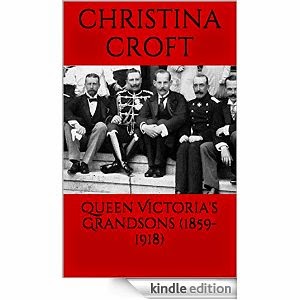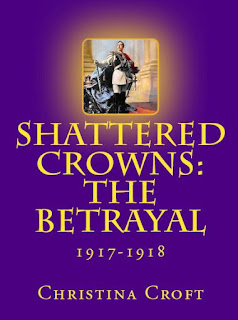Queen Victoria's Cousins
Throughout her lonely and isolated childhood, with only her dogs and dolls for company, Queen Victoria relished the visits of her cousins, many of whom she came to regard as surrogate brothers and sisters. From the newly-created Empire of Mexico, to the largely undiscovered African Congo, their influence crossed continents; and their lives, spanning more than a century, were interwoven with some of the most significant events of the age. They experienced wars, revolutions, personal tragedies and national disasters, and, as in any extended family, their characters were as varied as their experiences. Among them were princes, potentates and dukes; dutiful wives and desperate daughters; an Empress; three Kings; the consorts of Queens; and the spouses of theatre performers and a circus artiste.
With several, Queen Victoria maintained a lifelong correspondence, while others were gradually distanced from her. All, however, contributed something to her life’s experience, and many repaid her devotion with love.
Queen Victoria's Creatures
From a garrulous parrot that embarrassed an Archduke, to an injured fawn carried home in the arms of a Queen, animals featured largely in the lives of the royal families in the halcyon days of the European monarchies. Disruptive dogs, bothersome birds, faithful friends, family pets, livestock and working animals all had their place in palaces, but while these were generally treated with respect and affection, princes saw no incongruity between wilfully slaughtering other creatures for sport.
Throughout the 19th century, hundreds of thousands of birds were shot for entertainment, and, as empires expanded, hunters were proud to exhibit their trophies of more exotic animals, the heads and skins of which were boldly displayed on palace walls. This, too, though was the era of a growing awareness of the need to respect and protect our fellow creatures, and a number of royal voices were raised in defence of ‘our dumb friends’. One Queen purchased a large number of caged birds, solely to set them free; while a Duchess took in so many strays that the stench of her home became unbearable to visitors.
Sometimes amusing, sometimes tragic, the stories of these animals are each, in their own way, deeply moving, and, perhaps, in the retelling, we, too, can be reminded of the message of Queen Elizabeth of Roumania:
“If man really imagines that he is the lord of the creation…surely he has, before all, a tremendous responsibility toward his inferiors and must, perhaps, sometime give an account of the way in which he has treated these animals. If eternal retribution is a reality, if we are responsible, what shall we then suffer for the way in which we have treated God’s creatures.”
This book is dedicated to the thousands of unknown and innocent creatures who gave their lives for Man’s amusement, and the thousands more who continue to suffer such abuse today.
The Innocence of Kaiser Wilhelm II
 Almost a century after the signing of the Treaty of Versailles, Kaiser
Wilhelm II is still viewed as either a warmonger or a madman, as the
hundred-year-old propaganda posters remain fixed in the general
consciousness. Was he, though, truly responsible for the catastrophe of
the First World War, or was he in fact a convenient scapegoat, blamed
for a conflict which he desperately tried to avoid?
Almost a century after the signing of the Treaty of Versailles, Kaiser
Wilhelm II is still viewed as either a warmonger or a madman, as the
hundred-year-old propaganda posters remain fixed in the general
consciousness. Was he, though, truly responsible for the catastrophe of
the First World War, or was he in fact a convenient scapegoat, blamed
for a conflict which he desperately tried to avoid?The Goose Girl
When eighteen-year-old Stephen sees a mysterious woman running along a cliff top, he is desperate to discover more about her. His search compels him to reconsider his understanding of the world, and leads him into a mystery of mysticism and reincarnation, through turmoil and tragedy to ultimate redemption.
Dear Papa, Beloved Mama
“What a joyous childhood we had!” wrote Princess Alice, the second daughter of Queen Victoria and Prince Albert. These were no mere words and it was a sentiment shared by many of her siblings. Far from being the tyrannical or neglectful parents presented so often by the sensational press, Albert and Victoria devoted themselves to their children, doing their utmost to secure their happiness while preparing them for a future of personal fulfilment and service to their people in a rapidly-changing world. “Dear Papa, Beloved Mama” covers the period from 1840 to the death of Prince Albert in 1861, considering the far-reaching influence of the Queen and Prince in the lives of their children in wide-ranging areas from science and farming to music, art and marriage. Flying in the face of the current trend to condemn and criticise their parenting skills, this book penetrates the motives of Victoria and Albert and their sincere and loving efforts to create for their children a happy, constructive and memorable childhood.
Queen Victoria's Grandsons
Born into eight very different families, the upbringing and fortunes of Queen Victoria's grandsons varied widely. Some died in childhood, some were killed in action, and others lived to see grandchildren of their own. There were heroes and villains, valiant soldiers and dissipated youths, but their lives were interconnected through the tiny Queen for whom their welfare and happiness was a constant preoccupation. As part of a wide, extended family, they lived through the halcyon days of the late nineteenth century European monarchies, witnessing the most spectacular and the most tragic events of the age.
Alice, The Enigma
Of all Queen Victoria’s nine children, none was more intriguing than her second daughter, Alice. The
contradictions in her personality are so striking that, while she has often been overshadowed by her more illustrious brother, King Edward VII, and her brilliant sister, the German Empress Frederick, she remains to this day an enigma, the depths of whose character are virtually impossible to penetrate. By the time of her premature death at the age of only thirty-five, Alice had lived through two wars, had lost two of her children, and had exhausted herself in her devotion to duty to the extent that she suffered from disillusionment almost to the point of despair. Nonetheless, in the final tragic weeks of her life, she met unimaginable grief with courage and serenity, and her last words demonstrated her ultimate redemption and the beautiful restoration of all she had loved and lost.
Queen Victoria's Granddaughters 1860-1918
 On 6th July 1868, when told of the birth of her seventh
granddaughter, Queen Victoria remarked that the news was ‘a very uninteresting
thing for it seems to me to go on like the rabbits in Windsor Park.’ Her apathy
was understandable – this was her fourteenth grandchild, and, though she had
given birth to nine children, she had never been fond of babies, viewing them as
‘frog-like and rather disgusting…particularly when undressed.’ The early years
of her marriage had, she claimed, been ruined by frequent pregnancies; and large
families were unnecessary for wealthy people since the children would grow up
with nothing worthwhile to do. Nevertheless, her initial reaction to the birth
of Princess Victoria of Wales belied the genuine concern that Queen Victoria
felt for each of her twenty-two granddaughters. ‘As a rule,’ she wrote, ‘I like
girls best,’ and she devoted a great deal of time to their wellbeing and
happiness, showering them with an affection she had seldom shown her own
children.
On 6th July 1868, when told of the birth of her seventh
granddaughter, Queen Victoria remarked that the news was ‘a very uninteresting
thing for it seems to me to go on like the rabbits in Windsor Park.’ Her apathy
was understandable – this was her fourteenth grandchild, and, though she had
given birth to nine children, she had never been fond of babies, viewing them as
‘frog-like and rather disgusting…particularly when undressed.’ The early years
of her marriage had, she claimed, been ruined by frequent pregnancies; and large
families were unnecessary for wealthy people since the children would grow up
with nothing worthwhile to do. Nevertheless, her initial reaction to the birth
of Princess Victoria of Wales belied the genuine concern that Queen Victoria
felt for each of her twenty-two granddaughters. ‘As a rule,’ she wrote, ‘I like
girls best,’ and she devoted a great deal of time to their wellbeing and
happiness, showering them with an affection she had seldom shown her own
children.By 1914, through a series of dynastic marriages, the Queen’s granddaughters included the Empress of Russia, the Queens of Spain, Greece and Norway, and the Crown Princesses of Roumania and Sweden. As their brothers and cousins occupied the thrones of Germany, Britain and Denmark, Prince Albert’s dream of a peaceful Europe created through bonds of kinship seemed a real possibility. Yet in little more than a decade after Queen Victoria’s death, the Prince Consort’s dream would lie shattered in the carnage of the First World War. Royal cousins and even siblings would find themselves on opposing sides; two of them would die horrifically at the hands of revolutionaries and several others would be ousted from their thrones. They had lived through the halcyon days of the European monarchies but their lives, like the lives of millions of their peoples, would be changed forever by the catastrophe played out on the battlefields of France.Through all the upheavals, tragedies and conflicts one person had bound them together and, even when wars had divided their nations, to the end of their lives, they would look back and remember ‘dearest grandmama’ with love.
Most Beautiful Princess
At the age of nineteen, Queen Victoria's granddaughter, Princess Elizabeth
of Hesse, stepped into the glittering court of the Romanovs, beginning a journey
that would lead her from the shimmering ballrooms of St. Petersburg to the back
streets of Moscow. Through intrigues, assassination, war and revolution, to the
tragedy of her own horrific murder, she remained true to her calling to bring
beauty into the world. Based on the true story of 'the most beautiful princess
in Europe', this novel is written in tribute to a remarkable and courageous
woman.
"Elegantly written with care in depicting each character true to his/ her likeness, Christina Croft has taken a slice of the past and brought it back to life. Most Beautiful Princess will become an all-time favourite for historical fiction and non-fiction lovers alike." (Enchanted by Josephine - Canada)
"I have read several books on this subject. This book was the best so far. I found it well written, very enjoyable and the end was wonderfully written and up lifting although delving into truly horrific facts. Very inspirational. I will follow this author!" (Che Williamson, Texas, USA)
"I have to say I was surprised at how good this book was. The author seems to have a good grasp of the various royal characters in Elizabeth's life, and if you have read any memoirs or history books on the Romanovs you will appreciate how spot on the author's characterisations are and how true to history she has stayed with the story." (K. Maxwell, Sydney, Australia)
Shattered Crowns: The Scapegoats
On 28th June 1914, Archduke Franz Ferdinand and his morganatic wife, Sophie
Chotek, were shot dead in broad daylight on a crowded street in Sarajevo. The
murder of a relatively unknown archduke in a remote Bosnian city might well have
been quickly forgotten were it not for the fact that this seemingly minor event
ignited a spark that would explode into one of the bloodiest conflicts in
history. Within four years, over sixteen million people from one hundred
countries would lie dead on the battlefields of the First World War. By 1914,
through a series of alliances, Europe was largely divided into two separate
camps: the Triple Alliance of the Central Powers of Germany, Austria-Hungary and
Italy, and the Triple Entente of Russia, Britain and France. The clashing of
these empires has often led to the First World War being described as an
Imperial War and their emperors have provided a convenient scapegoat on which to
pin the blame for the consequent slaughter. In reality, however, not one of
these monarchs – who were close friends and cousins – had any desire for war and
each of them struggled desperately to maintain peace. “All our cousins,” wrote
Princess Marie Louise of Schleswig-Holstein, “were more like brothers and
sisters than mere blood relations.” This novel – the first in a trilogy
following the royalties of Europe from 1913 to 1918 – tells the story of the
year leading up to the outbreak of war and the very human tragedy that befell
those cousins and friends; a tragedy which might have been deliberately
engineered to lead to the destruction of the Russian, Austrian and German
monarchies.
"This is a an excellent novel - historical fiction at its finest and very well
written." (S. Riaz - United Kingdom)
"The lively and realistic conversations between the characters will captivate
you. The vivid landscapes and happenings will draw you in completely...There are some amazing and ground-breaking thoughts here! Be
prepared to completely re-think your previous notions about the first World War." (Victoria Lynne - United States)
In the summer of 1914 the capitals of Europe erupt in a patriotic frenzy as peoples on all sides, roused by the press, rejoice at the outbreak of the 'war to end wars'. The rejoicing soon turns to disillusionment as the full horrors of the bloodiest conflict the world has ever seen become apparent. For the Emperors of Germany, Austria-Hungary and Russia comes the growing awareness that this war, which they sought desperately to avoid, is not being fought for territory or honour, but rather to destroy the old world order and to replace their autocracies with secular ideologies and international economic control. Amid the intrigue and deception, Kaiser Wilhelm, Tsar Nicholas, Emperor Franz Josef, Archduke Karl, and Queen Marie of Roumania not only face the horrific sacrifice of their people, but are also confronted by their own personal and family tragedies. 'The Sacrifice' is the second novel in the Shattered Crowns trilogy, following the royalties of Europe from 1913 to the Treaty of Versailles. 'The Sacrifice' covers the the period from the outbreak of war to the Russian revolution (1914-1917) and is based on actual events.
"Reading the Sacrifice made me feel as though I was actually present with the Imperial families, as they struggled to manage World War 1." (Erik - USA)
"An amazingly gifted author who not only writes well and has done an incredible amount of research, but also clearly has an excellent grasp of psychology!" ('Dolly' - United Kingdom)
Spring 1917 – the war has been raging for over two and a half
years and neither the Central Powers (Germany, Austria-Hungary and Turkey) nor
the Entente (Britain, France, Russia and Italy) are any closer to a decisive
victory. In Russia, the Revolution and enforced abdication of the Tsar has left
the country in the shaky hands of the Provisional Government but as the
Bolsheviks begin to seize power it is clear that behind the scenes something
rather sinister is occurring. Both Kaiser Wilhelm of Germany, and Karl, the new
Emperor of Austria-Hungary, are eager to pursue peace but the United States’
entry into the war thwarts their efforts and leaves them convinced that the true
aim of the conflict is the destruction of their monarchies.
Based on actual events, ‘The Betrayal’ is the third book of the ‘Shattered Crowns’ trilogy which follows the tragic story of the royalties who sought peace throughout the bloodiest conflict of the 20th century.
Based on actual events, ‘The Betrayal’ is the third book of the ‘Shattered Crowns’ trilogy which follows the tragic story of the royalties who sought peace throughout the bloodiest conflict of the 20th century.
"This series ought to be required reading in all the academies and universities
where the history of WW1 is taught, and is also a wonderful read for anyone who
enjoys historical fiction with strong characterization and a gripping plot." (Elizabeth Alexandra - United States)
 When a wealthy landowner plans to enclose the Yorkshire village of Lowkirk
and move his tenants to work in the town, his daughter, Caroline Brandwith, is
forced to disclose a secret she has kept for ten years. The revelation leads her
into conflict with her family; a conflict which is heightened when her father
attempts to destroy the man she loves. Confronted not only by his cruelty to
her, but also by the appalling treatment of the pauper apprentices and the
insanitary housing conditions of the workers at Brandwith's Mill, Caroline
realizes she has no option but to stand up against
injustice...
When a wealthy landowner plans to enclose the Yorkshire village of Lowkirk
and move his tenants to work in the town, his daughter, Caroline Brandwith, is
forced to disclose a secret she has kept for ten years. The revelation leads her
into conflict with her family; a conflict which is heightened when her father
attempts to destroy the man she loves. Confronted not only by his cruelty to
her, but also by the appalling treatment of the pauper apprentices and the
insanitary housing conditions of the workers at Brandwith's Mill, Caroline
realizes she has no option but to stand up against
injustice...
When seven-year-old Georgie, desperate to win the attention of her hero,
James, steals a candlestick from a cemetery lodge, she believes that the devil
has seen her and will follow her home. Her conviction is heightened that evening
when tragedy strikes the family. Guilt-ridden, Georgie sets out on a quest to
become a saint, in the hope that God will grant her a miracle. Her sincere but
often bizarre efforts lead her through various escapades from a remote Yorkshire
farmhouse to being lost in London, when she is accosted by a sinister stranger.
The arrival of a distant relative throws her world into greater confusion as she
comes to understand the nature of good, evil and accident. The story is
populated by a variety of eccentric characters; feisty ex-suffragette, GreatAunt
Lucy; the pious but increasingly senile Great Aunt Philomena; beautiful French
Aunt Marie and her huge explorer husband; the cruel teacher, Miss Keppel; and
the contrasting personalities of Georgie and her friends and
siblings.
By Any Other Name
 Haunted by a painting seen in the Louvre,
Haunted by a painting seen in the Louvre,a young artist returns to her native town to
discover the truth about what happened to her mother, who is believed to have committed suicide. As the mystery unfolds, she finds herself drawn into a web of intrigue and hypocrisy, leading to a startling conclusion...














3 comments:
I so enjoyed your book Queen Victoria's Grand-daughters 1860-1918. It was a geat read and I'm now looking forward to reading some of the others. Just wondered if the Queen Vic book is available in hard copy or only as an ebook. I would love to give it as a gift to a friend. Kind regards,
Andrea Glover
Hello, Andrea. Thank you so much for your very kind comment - I am so pleased that you enjoyed the book. Initially it was meant only as an e-book but, hopefully, towards the end of the summer it will also be available in paperback.
Thank you again for your kindness.
This book is now available in paperback format.
Post a Comment